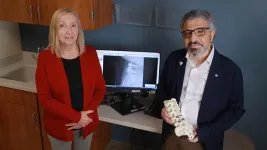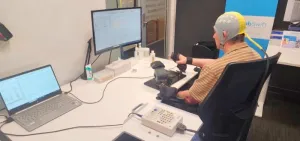(Press-News.org) Adolescents worldwide have embraced social media and online platforms for self-expression and to explore their identity. This freedom, however, can lead to risky behaviors, especially with limited adult supervision. For example, digital self-harm is a recent, emerging trend where individuals anonymously post or share hurtful content about themselves online. This behavior can be mistaken for mistreatment by others, yet the perpetrator and victim are the same person.
First identified in 2010, digital self-harm has not received the same amount of scholarly scrutiny as other forms of self-directed abuse and has not been widely addressed by adults working with youth.
To address this growing issue, researchers from Florida Atlantic University and the University of Wisconsin-Eau Claire analyzed three independent national surveys (2016, 2019 and 2021) of teens in the United States ages 13 to 17, to assess the prevalence of digital self-harm. They explored two measures of digital self-harm: if teens had anonymously posted something mean about themselves online in their lifetime and if they had anonymously cyberbullied themselves online in their lifetime.
Results of the study, published in the Journal of School Violence, reveal that a meaningful proportion of U.S. youth has been involved in digital self-harm. Between 2019 and 2021, approximately 9 to 12% of 13 to 17 year olds in the U.S. engaged in digital self-harm, a more than 88% increase since 2016. This upward trajectory, particularly among specific demographic groups, highlights the need for targeted interventions and support systems – especially given that research has shown a strong association between digital self-harm and traditional self-harm, as well as between digital self-harm and suicidality.
The current study included three demographic variables: gender, race and sexual orientation, and also examined whether individuals who experienced cyberbullying were more likely to engage in digital self-harm. Cyberbullying was defined as when someone repeatedly harasses, mistreats, or makes fun of another person (on purpose to hurt them) online or while using cell phones or other electronic devices.
Among the study’s key findings:
In 2016, 6.3% of students anonymously posted mean content about themselves online, while 4.1% anonymously cyberbullied themselves. Male students were more likely than females to anonymously cyberbully themselves. Non-heterosexual students were significantly more likely than heterosexual students to engage in both forms of digital self-harm.
In 2019, rates increased, with 9% anonymously posting mean content and 5.3% anonymously cyberbullying themselves. Non-heterosexual youth continued to exhibit higher rates of digital self-harm.
In 2021, rates increased further, with 11.9% anonymously posting mean content and 9.3% anonymously cyberbullying themselves. Female and non-heterosexual youth were significantly more likely to engage in digital self-harm.
Students who experienced cyberbullying were five to seven times more likely to have digitally self-harmed compared to students who had not been cyberbullied.
While there were no consistent race differences across all years, students from racial backgrounds other than white were more likely to anonymously post mean things about themselves online. Hispanic students were more likely than white students to anonymously cyberbully themselves.
Female and non-heterosexual youth are consistently more likely to engage in digital self-harm compared to male and heterosexual youth. Non-heterosexual youth particularly show a significantly higher likelihood of participating in both forms of digital self-harm across all years.
“Digital self-harm has been linked with major issues such as bullying, depression, eating disorders, physical harm, sleep disturbances and even suicidal tendencies,” said Sameer Hinduja, Ph.D., co-author, a professor in the School of Criminology and Criminal Justice within FAU’s College of Social Work and Criminal Justice, co-director of the Cyberbullying Research Center, and a faculty associate at the Berkman Klein Center at Harvard University. “With increasing global attention from youth-serving professionals on this phenomenon, it's clear that digital self-harm is a significant public health issue that warrants further research to identify solutions that can serve as protective factors to forestall its incidence as well as its impact.”
Several motivations have previously been identified that contribute to digital self-harm such as self-hate, to be funny, to seek attention, the desire to look cool, to show resilience and toughness, or a cry for help.
“It's also crucial to understand why young people engage in digital self-harm and help them develop healthier coping mechanisms,” said Hinduja. “Moreover, it’s essential that parents, educators and mental health professionals working with young people extend support to all targets of online abuse in informal and conversational, as well as formal and clinical settings.”
Study co-author is Justin Patchin, Ph.D., a professor of criminal justice, University of Wisconsin-Eau Claire and co-director of the Cyberbullying Research Center.
- FAU -
About Florida Atlantic University:
Florida Atlantic University, established in 1961, officially opened its doors in 1964 as the fifth public university in Florida. Today, the University serves more than 30,000 undergraduate and graduate students across six campuses located along the southeast Florida coast. In recent years, the University has doubled its research expenditures and outpaced its peers in student achievement rates. Through the coexistence of access and excellence, FAU embodies an innovative model where traditional achievement gaps vanish. FAU is designated a Hispanic-serving institution, ranked as a top public university by U.S. News & World Report and a High Research Activity institution by the Carnegie Foundation for the Advancement of Teaching. For more information, visit www.fau.edu.
END
The University of Texas at San Antonio (UTSA) has joined one of two newly established university consortia committed to nuclear security and nonproliferation. The consortia were awarded $50 million in cooperative agreements by the Office of Defense Nuclear Nonproliferation in the U.S. Department of Energy’s National Nuclear Security Administration (DOE NNSA).
“The pressing challenges of nuclear security and nonproliferation require a concerted effort from experts across the country,” said JoAnn Browning, UTSA interim vice president for research. ...
A new study from orthopaedic researchers at The University of Toledo has found lumbar spinal fusion procedures are far more likely to fail in individuals with diabetes.
“We’ve known for a long time that diabetic patients are at high risk of infection from any surgery, including spinal fusion,” said Dr. Hossein Elgafy, a professor of orthopaedics in the College of Medicine and Life Sciences and chief of spine surgery at UTMC. “More recently, however, physicians have taken a closer look at the high ...
A personalized brain-computer interface therapy, RehabSwift, significantly enhances hand mobility for stroke survivors. Strokes often lead to impaired hand function, presenting substantial challenges in daily activities. Sam Darvishi and colleagues developed and tested a brain-computer interface therapy that translates imagined hand movements into real actions using a personalized algorithm and bionic hands. The study involved twelve chronic stroke survivors from South Australia who had limited use of their arms but retained clear thinking abilities. Throughout 18 sessions, participants used the RehabSwift system, which included a special cap that ...
MILL VALLEY, Calif. – July 9, 2024 – SynGAP Research Fund (SRF), a 501(c)(3) public charity whose mission is to improve the quality of life for patients suffering from SYNGAP1-Related Disorders (SRD) through the research and development of treatments, therapies, and support systems, has awarded a $130,000 grant to the University of Southern California’s Quadrato Lab to inspect and stratify the effects of specific SYNGAP1 variants on their patient-derived neuronal model system, furthering the world’s understanding ...
New research highlights the challenge of balancing the risks of overdiagnosing and underdiagnosing prostate cancer early enough to intervene and minimize risk of death. Recently, some experts have called for the lowest grade of prostate cancer—biopsy Gleason Grade Group (GGG) 1—to be reclassified as ‘benign.’ But a new study led by a researcher from Mass General Brigham has found that many patients with a biopsy GGG1 may have a more aggressive cancer than their biopsy alone suggests.
By looking at data from more than 10,000 patients at a university in Germany, researchers found that at least 8 percent of patients with this ...
The Royal Spanish Society of Chemistry (RSEQ) and Lilly have announced the winning theses of the 22nd Research Awards for Doctoral Students, which acknowledge outstanding work in the fields of Organic, Pharmaceutical, and Analytical Chemistry. Marcos Vilela, currently pursuing his PhD at the Center for Research in Biological Chemistry and Molecular Materials (CiQUS) at the University of Santiago de Compostela (USC), was awarded alongside Andrea Palone from the University of Girona (UdG) and the University of Rome "Tor Vergata," and Beatriz Arévalo from the Complutense University of Madrid (UCM).
Marcos' thesis, supervised by CiQUS Principal ...
PULLMAN, Wash. – While not yet on the market, fully autonomous vehicles are promoted as a way to make road travel dramatically safer, but a recent study found that knowing more about them did not improve people’s perception of their risk. They needed to have more trust in them too.
This study adds to the evidence from other research that knowledge alone is not enough to sway people’s attitudes toward complex technology and science, such as gene editing or climate change. In this case, Washington State University researchers found that trust in the autonomous vehicles’ reliability and performance played the strongest role in improving ...
The ability to recognise and respond to emotionally-charged situations is essential to a species’ evolutionary success. A new study published today [July 9th] in Nature Communications advances our understanding of how the brain responds to emotionally charged objects and scenes.
The research, led by Trinity College Dublin neuroscientist Prof. Sonia Bishop and Google researcher Samy Abdel-Ghaffar while he was a PhD student in Prof. Bishop's lab at UC Berkeley, has identified how the brain represents different categories of emotional stimuli in a way that allows for ...
New research led by UCLA Health has found a drug that treats insomnia works to prevent the addictive effects of the morphine opioids in mice while still providing effective pain relief.
The study, published in the journal Nature Mental Health, concluded that suvorexant, which blocks brain receptors for a neurotransmitter called hypocretin, prevents opioid addiction. At high doses in humans, suvorexant induces sleep and is used to treat insomnia. But sleep was not induced, and behavioral alertness was maintained, at the much lower doses effective in preventing ...
Many women treated for breast cancer using taxanes, a type of cytostatic drug, often experience side effects in the nervous system. Researchers at Linköping University have developed a tool that can predict the risk level for each individual. The tool could help doctors adapt treatment to avoid persistent side effects in those at the greatest risk.
More and more people are becoming cancer survivors. But even if they have survived the disease, an increasing number still suffer from the side effects of cancer treatment. In a recent study from Linköping University, researchers studied the side effects of taxanes, ...






